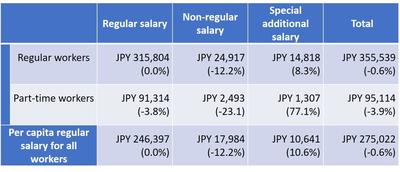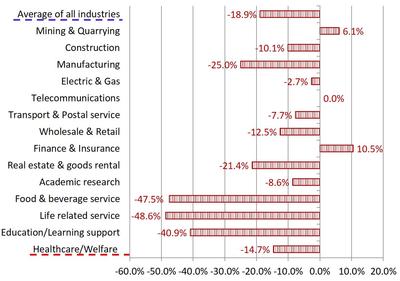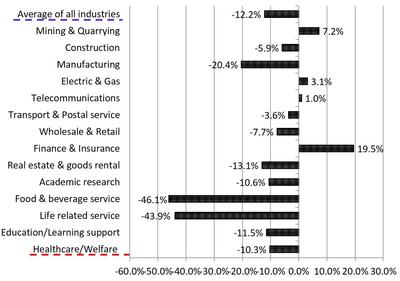Column Finance and the Social Security System 2020.06.30
【Aging, safety net and fiscal crisis in Japan】No.239: Workers' incomes decrease due to a sharp decline in overtime hours
The Ministry of Health, Labour and Welfare publishes a survey report of monthly working hours and salaries for regular and part-time workers. Salaries collected in the survey are classified into three types: regular salary, non-regular salary, and special additional salary. A regular salary is paid for standard working hours, whereas a non-regular salary is paid for work exceeding the standard time, night shift work, and work on holidays. The amount of a special additional salary is either not fixed in advance or the occurrence of payment is uncertain. For example, there are bonuses and marriage allowances.
The breakdown of workers surveyed in April 2020 was 69.46% for regular workers and 30.54% for part-time workers. As shown in Table 1, the per capita regular salary for all workers was JPY 246,397 (US$ 2,280), which is the same as it was in April 2019. On the other hand, the amount of non-regular salaries decreased by 12.2% from the previous year to JPY 17,984 (US$ 166). This reflects the stagnation of economic activity in an attempt to prevent COVID-19 infections.
Figure 1 shows the rate of change in overtime work hours covered by non-regular salaries in April 2020 compared to April 2019, by industry type. The figure illustrates a more than 40% reduction in overtime work hours for workers in food and beverage services, life-related services, and Education/Learning support. These figures are unsurprising because of the temporary closure of restaurants, gyms, schools, and cram schools. However, it is interesting to note that the overtime work hours in Healthcare/Welfare, a sector that has been extremely busy saving people infected with COVID-19, decreased by 14.7% and the amount of non-regular salaries decreased by 10.3%. This is because people refrained from going to medical institutions due to fear of COVID-19.
Table 1 Breakdown of workers' salaries in April 2020
 *Please click the table image to find the original size image.
*Please click the table image to find the original size image.
Note 1: (%) indicates growth rate compared to April 2019.
Note 2: The breakdown of the workers surveyed is 69.46% for regular workers and 30.54% for part-time workers.
Source: Ministry of Health, Labour and Welfare
Figure 1 Overtime work hours for April 2020 compared to April 2019
 *Please click the table image to find the original size image.
*Please click the table image to find the original size image.
Source: Ministry of Health, Labour and Welfare
Figure 2 Non-regular salary for April 2020 compared to April 2019
 *Please click the table image to find the original size image.
*Please click the table image to find the original size image.
Source: Ministry of Health, Labour and Welfare
